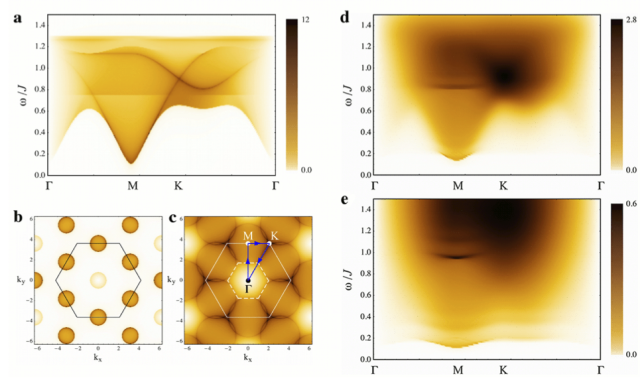
Quenched disorder at antiferromagnetic quantum critical points in two-dimensional metals
J. Halbinger, M. Punk
Physical Review B 103 (23), 235157 (2021).
We study spin density wave quantum critical points in two-dimensional metals with a quenched disorder potential coupling to the electron density. Adopting an E expansion around three spatial dimensions, where both disorder and the Yukawa-type interaction between electrons and bosonic order parameter fluctuations are marginal, we present a perturbative, one-loop renormalization group analysis of this problem, where the interplay between fermionic and bosonic excitations is fully incorporated. Considering two different Gaussian disorder models restricted to small-angle scattering, we show that the non-Fermi liquid fixed point of the clean spin density wave (SDW) hot spot model is generically unstable and the theory flows to strong coupling due to a mutual enhancement of interactions and disorder. We study properties of the asymptotic flow towards strong coupling, where our perturbative approach eventually breaks down. Our results indicate that disorder dominates at low energies, suggesting that the ground state in two dimensions is Anderson-localized.

From Luttinger liquids to Luttinger droplets via higher-order bosonization identities
S. Huber, M. Kollar
Physical Review Research 2 (4), 43336 (2020).
We derive generalized Kronig identities expressing quadratic fermionic terms including momentum transfer to bosonic operators and use them to obtain the exact solution for one-dimensional fermionic models with linear dispersion in the presence of position-dependent local interactions and scattering potential. In these Luttinger droplets, which correspond to Luttinger liquids with spatial variations or constraints, the position dependencies of the couplings break the translational invariance of correlation functions and modify the Luttinger-liquid interrelations between excitation velocities.

Slave-boson description of pseudogap metals in t-J models
J. Brunkert, M. Punk
Physical Review Research 2 (4), 43019 (2020).
We present a simple modification of the standard U(1) slave boson construction for the single band t-J model which accounts for two-particle bound states of spinons and holons. This construction naturally gives rise to fractionalized Fermi-liquid ground states, featuring small, hole-like pocket Fermi surfaces with an anisotropic quasiparticle weight in the absence of broken symmetries. In a specific parameter regime our approach maps the square lattice t-J model to a generalized quantum dimer model, which was introduced as a toy model for the metallic pseudogap phase in hole-doped cuprates in [Proc. Natl. Acad. Sci. USA 112, 9552 (2015)]. Our slave boson construction captures essential features of the nodal-antinodal dichotomy and straightforwardly describes sharp, Fermi arc-like features in the electron spectral function. Moreover, it allows us to study quantum phase transitions between fractionalized Fermi-liquid phases and superconductors or ordinary Fermi liquids.

Solvable lattice models for metals with Z2 topological order
B. Verheijden, Y. H. Zhao, M. Punk
Scipost Physics 7 (6), 74 (2019).
We present quantum dimer models in two dimensions which realize metallic ground states with Z2 topological order. Our models are generalizations of a dimer model introduced in [PNAS 112, 9552-9557 (2015)] to provide an effective description of unconventional metallic states in hole-doped Mott insulators. We construct exact ground state wave functions in a specific parameter regime and show that the ground state realizes a fractionalized Fermi liquid. Due to the presence of Z2 topological order the Luttinger count is modified and the volume enclosed by the Fermi surface is proportional to the density of doped holes away from half filling. We also comment on possible applications to magic-angle twisted bilayer graphene.

Incommensurate 2k(F) density wave quantum criticality in two-dimensional metals
J. Halbinger, D. Pimenov, M. Punk
Physical Review B 99 (19), 195102 (2019).
We revisit the problem of two-dimensional metals in the vicinity of a quantum phase transition to incommensurate Q = 2k(F) charge-density-wave order, where the order-parameter wave vector Q connects two hot spots on the Fermi surface with parallel tangents. Earlier theoretical works argued that such critical points are potentially unstable, if the Fermi surface at the hot spots is not sufficiently flat. Here we perform a controlled, perturbative renormalization-group analysis and find a stable fixed point corresponding to a continuous quantum phase transition, which exhibits a strong dynamical nesting of the Fermi surface at the hot spots. We derive scaling forms of correlation functions at the critical point and discuss potential implications for experiments with transition-metal dichalcogenides and rare-earth tellurides.

